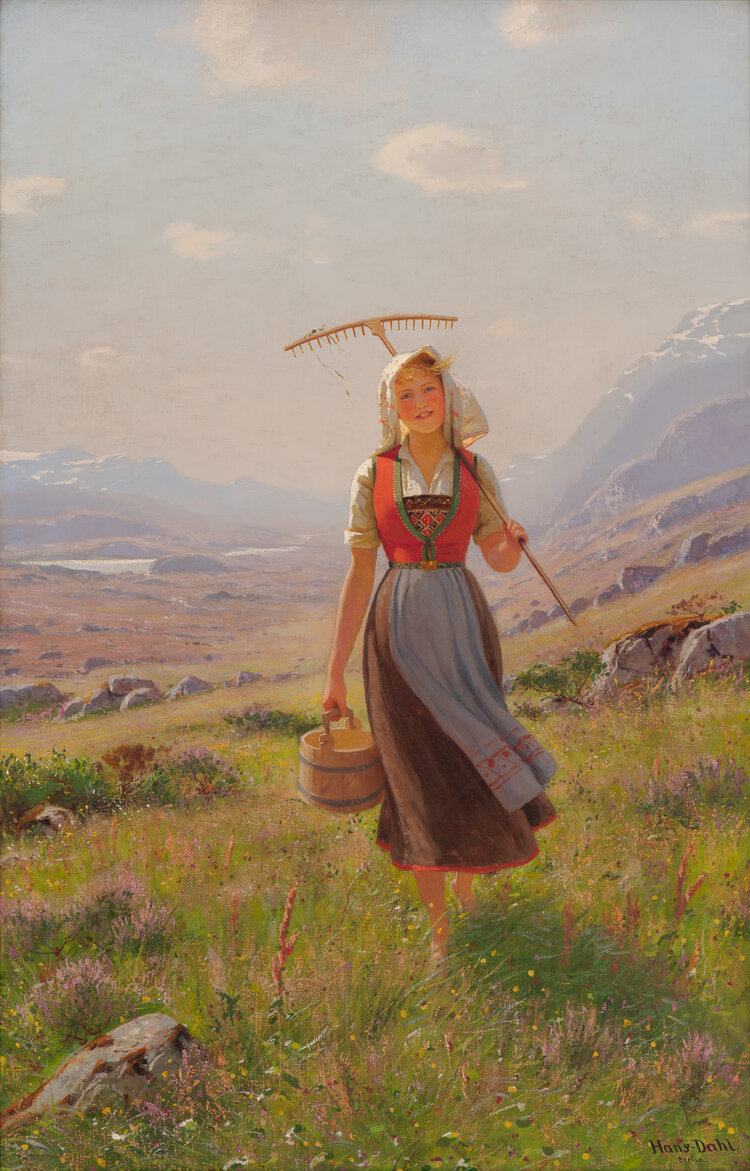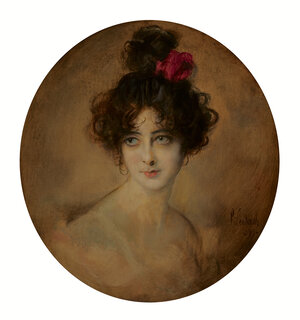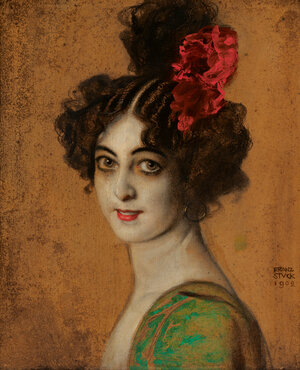GET INSPIRED
Charles and Emma Frye collected many portraits. A portrait is a representation of a real or imagined person, sometimes showing mostly the head and shoulders while other times showing the entire body. A portrait can be in the form of a painting, drawing, photograph, print, or even sculpture.
Why do artists create portraits? Before photography was developed in the early 1800s, an artist-rendered portrait was the only way to record a person’s appearance. However, a portrait is more than a record. Through clothing, other objects included, or background location, a portrait can also suggest the personality, profession, social status, and other qualities of the sitter. A sitter is a person who poses for a portrait.
An artist holds a lot of power in deciding on how a person appears in a portrait. Does a portrait always represent the truth and illustrate what an artist actually sees in front of them or instead focus on the preferences of the sitter or viewer? Can a portrait be an artist’s make-believe? If elements of a portrait are made up, why would an artist do that? The exhibition Unsettling Femininity: Selections from the Frye Art Museum Collection explores these ideas while showcasing portraits of various types of female figures from the late nineteenth and early twentieth centuries. A figure is a depiction of a human form in a work of art.

Hans Dahl. Norwegian Girl, ca. 1905. Oil on canvas. 57 1/2 x 36 3/8 in. Founding Collection, Gift of Charles and Emma Frye, 1952.026. Photo: Jueqian Fang.
Take a moment and carefully observe this portrait. Who do you think this person might be? What is she holding in her hands? How might you describe her clothing?
Based on her surroundings, where do you think this might be? What do you notice in this setting? If you were this person in the painting, what do you think you might hear? What might you smell in the air?
Look at her facial expression. How might she be feeling at this moment? What do you think she might be thinking?
If you were to title this painting, what might you name it? The Norwegian artist Hans Dahl may have originally titled it as On the Mountain Plateaus of Norway, but the Frye Art Museum currently refers to it Norwegian Girl.
Sometimes artists use one sitter as their model to paint from, while other times they take inspiration from multiple sitters for the same painting. While we don’t know if Dahl painted this painting from just one sitter or multiple sitters, we do know that he found inspiration in the Norwegian landscapes, people, and traditional clothing. Do you think she was a real person?
At the time this painting was created around 1900-1910, the folk costume from the Hardanger region in western Norway in which the girl is dressed would have only been worn on special occasions. However, Dahl made a choice to present a timeless vision of a young farm worker, connecting her to specific traditional ideals of the time.
Check out Dahl's other paintings in the Frye’s Collection. Which one is your favorite?

Franz von Lenbach. Saharet, 1899. Oil on cardboard. 25 x 23 3/8 x 1/4 in. Founding Collection, Gift of Charles and Emma Frye, 1952.104. Photo: Jueqian Fang.

Franz von Stuck. Saharet, 1902. Oil on cardboard. 18 7/8 x 14 5/8 x 1/8 in. Founding Collection, Gift of Charles and Emma Frye, 1952.164. Photo: Jueqian Fang.
Here are two other portraits in the exhibition. How are these different from the first painting we looked at? Unlike the previous portrait showing an entire figure in a specific environment, these two portraits focus on just the faces in unknown settings. Why do you think the artists chose to use a blank background and exclude the rest of the figures?
Based on their facial expressions, do you think they look at ease, curious, alluring, or something else? How might you describe them? If you were to fill in a thought bubble for them, what do you think these figures might be thinking or feeling at this moment?
Comparing the two portraits, how are they similar to or different from one another? Other than the facial expressions, what do you notice about their facial features?
You might notice some similarities between the two figures. In fact, both paintings depict the same sitter painted by two different artists. The paintings are both titled Saharet, which is the stage name for a celebrated Australian performer named Paulina Clarissa Molony. While Franz von Lenbach painted Saharet in a softer color palette with blue eyes gazing to the left of the painting, Franz von Stuck presents Saharet in her stage makeup with pale white skin, dark contoured eyes, and bright red lips, looking straight into the viewer’s eyes. Why do you think these two artists painted the same figure so differently?
As we mentioned earlier, an artist makes choices about how to represent their sitter, sometimes even changing their appearance to convey a certain message or uphold beauty standards of the time. In the case of Saharet, Lenbach’s choice to make her eyes blue may have been for this kind of reason. Saharet, in fact, went to great lengths to hide her mother’s partial Chinese ancestry due to the widespread discrimination faced by people of Chinese and Asian descent in Australia and America. The grayish brown color of her eyes in Stuck’s painting is most probably closer to her true eye color.
If you were to have your portrait painted by an artist, how would you like to appear in the portrait? Rather than hiding your identity like Saharet, how would you help an artist show your true self in a portrait?
MAKE SOME ART
As you explore the rest of the paintings from this exhibition, find a portrait you like, make a quick sketch of the painting, and consider what the figure in the painting might be thinking or feeling before filling in a thought bubble. Download this activity sheet to help you with this exercise!
For some extra guidance on portrait drawing, check out this portrait how-to video.
SHARE YOUR WORK
Once you are done with the activity sheet or your portrait drawing, please share it with us on social media using #FryeFromHome.
Unsettling Femininity: Selections from the Frye Art Museum Collection closes on May 30, 2021.
Lynn Chou
Manager, Youth & School Programs